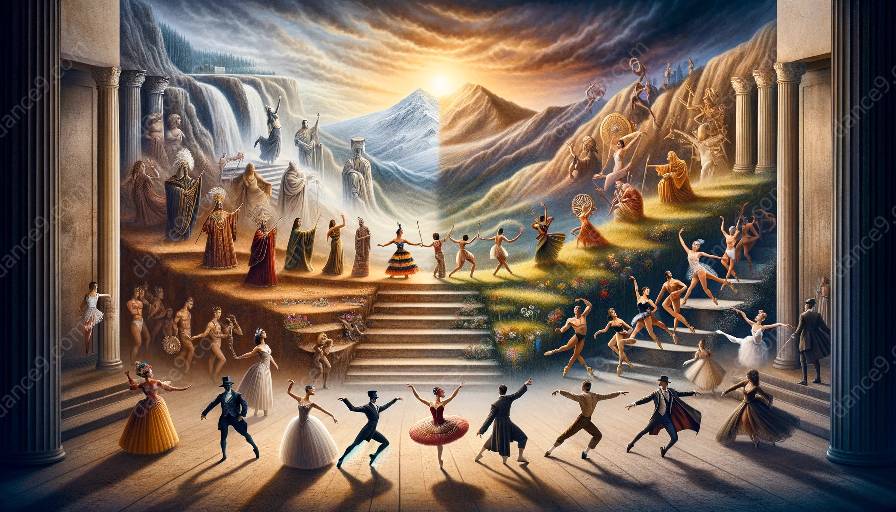Choreography has a rich historical background that intertwines with environmental and site-specific practices, creating innovative and immersive dance experiences. In this article, we will delve into the historical overview of choreography, explore the evolution of environmental and site-specific choreographic practices, and understand their significance within diverse settings.
Historical Overview of Choreography
The art of choreography traces its roots back to ancient civilizations where dance was an integral part of rituals, ceremonies, and storytelling. As societies evolved, choreography began to formalize into structured sequences of movement, often performed to music or rhythmic patterns. Over time, choreographers experimented with various styles and techniques, leading to the emergence of diverse dance forms such as ballet, modern dance, and contemporary dance.
The Impact of Choreography
Choreography has been a driving force in shaping the dance landscape, influencing cultural movements, and serving as a means of artistic expression. The evolution of choreography has reflected societal changes, technological advancements, and cross-cultural interactions, expanding its creativity and relevance. With its ability to convey emotions, narratives, and abstract concepts, choreography continues to captivate audiences worldwide, while also advocating for social and environmental causes.
Environmental Choreographic Practices
Environmental choreography transcends traditional performance spaces, embracing natural landscapes, urban environments, and alternative venues as creative canvases. Choreographers explore the relationship between movement and the environment, incorporating elements such as weather, terrain, and architecture into their compositions. Environmental choreographic practices engage with ecological themes, raising awareness of environmental challenges and promoting sustainable practices through artistic interventions.
- Immersive Dance Performances: Environmental choreography features immersive experiences that invite audiences to interact with dance in unconventional settings, fostering a deeper connection with nature and urban environments.
- Site-Specific Explorations: Choreographers design site-specific works that respond to the unique characteristics of a particular location, enhancing the audience's perception of space and encouraging a reimagining of familiar surroundings.
- Ecological Advocacy: Through movement and visual storytelling, environmental choreography advocates for environmental conservation, resource sustainability, and the impact of human activity on the planet, becoming a powerful tool for environmental education and advocacy.
Site-Specific Choreographic Practices
Site-specific choreography emphasizes the interaction between dance and the context in which it unfolds, blurring the boundaries between performance and everyday life. By engaging with specific sites, whether historical landmarks, industrial spaces, or public realms, choreographers create choreographic narratives that resonate with the inherent characteristics of the chosen environments. This practice challenges the conventional notions of performance spaces, inviting audiences to re-evaluate their relationship with the built environment and societal constructs.
- Artistic Contextualization: Site-specific choreography embeds dance within specific cultural, architectural, and historical contexts, allowing choreographers to weave narratives that reflect the essence and history of the chosen locations.
- Reconceptualizing Public Spaces: By utilizing public spaces as performance venues, site-specific choreography redefines the communal use of urban landscapes, transforming mundane locations into stages for artistic expression and communal engagement.
- Spatial Narratives: Choreographers craft spatial narratives that interact with the inherent characteristics of the chosen sites, exploring the interplay between movement and architecture, natural elements, and human activity.
Significance and Evolution
Environmental and site-specific choreographic practices have significantly expanded the scope of choreography, offering new dimensions for artistic exploration and cultural engagement. The convergence of choreography and environmental contexts has redefined the boundaries of dance, fostering interdisciplinary collaborations and reimagining the relationship between movement and space. This evolution has not only enriched the dance repertoire but also facilitated dialogues on pressing social and environmental issues, amplifying the impact of choreographic practices beyond conventional performance venues.
Diverse Contexts and Environments
Choreographic practices evolve within diverse contexts and environments, reflecting the cultural, social, and environmental dynamics of specific regions and communities. From rural landscapes to urban centers, choreographers adapt their creative processes to resonate with the unique characteristics of each environment, fostering a deeper understanding of local identities and global interconnectedness through dance.
Conclusion
Environmental and site-specific choreographic practices continue to serve as dynamic platforms for artistic innovation and cultural dialogue. As choreography embraces diverse environments and contexts, it reinvigorates the dance landscape, offering immersive experiences that resonate with societal and environmental issues. The historical overview of choreography intertwines with contemporary practices, creating a vibrant tapestry of movement, space, and storytelling, enriching the cultural heritage and relevance of dance in an ever-changing world.






































